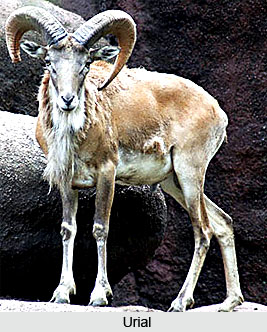 Urial (Ovis orientalis) or Red Sheep as it is sometimes called, is thought to be the ancestor of domestic sheep stock though its appearance is very different from its domesticated descendants. They are long-legged animals with harsh short reddish fur and no underwool. The belly and legs are whitish. Both sexes carry horns but in the male they curve outwards often in a very symmetrical semicircle. Rams also have a prominent chest ruff of long black hair. Practically confined to Pakistan, there are three recognizable subspecies occurring, one in Baluchistan, one confined to the Punjab Salt Range and a third found in the far northern regions of Chitral, Gilgit and Baltistan.
Urial (Ovis orientalis) or Red Sheep as it is sometimes called, is thought to be the ancestor of domestic sheep stock though its appearance is very different from its domesticated descendants. They are long-legged animals with harsh short reddish fur and no underwool. The belly and legs are whitish. Both sexes carry horns but in the male they curve outwards often in a very symmetrical semicircle. Rams also have a prominent chest ruff of long black hair. Practically confined to Pakistan, there are three recognizable subspecies occurring, one in Baluchistan, one confined to the Punjab Salt Range and a third found in the far northern regions of Chitral, Gilgit and Baltistan.
Normally these animals inhabit lower hills and spurs and avoid the precipitous crags so liked by Ibex and Markhor.
These wild sheep rest by day in some sheltered ravine and graze early in the morning and evening. Small bands of immature males and females will forage and rest together, whereas outside of the rutting season (during the month of November) the old rams tend to congregate in separate flocks. The young lambs are usually born singly but twins do occur, and are dropped in earlier parts of the month of April and are able to run about and follow their mother within an hour of birth.
This article is a stub. You can enrich by adding more information to it. Send your Write Up to content@indianetzone.com











